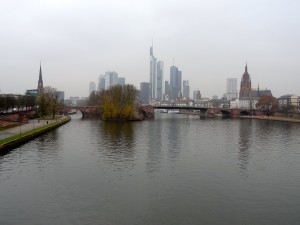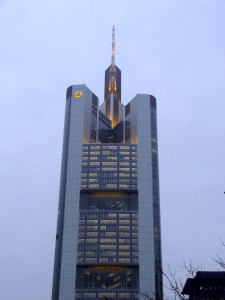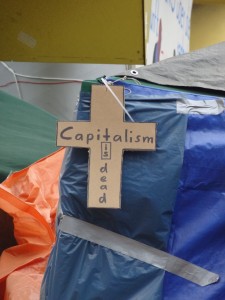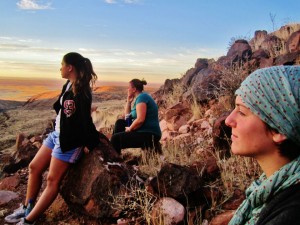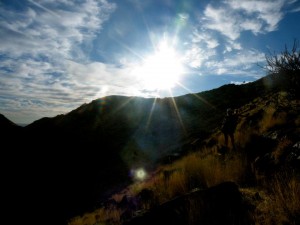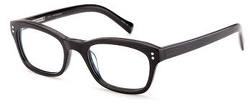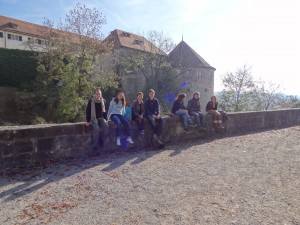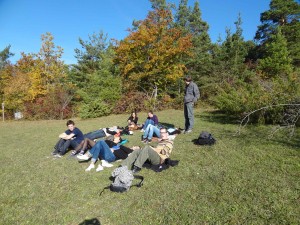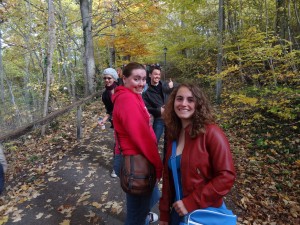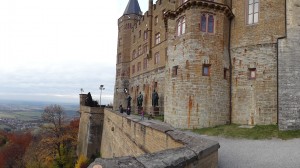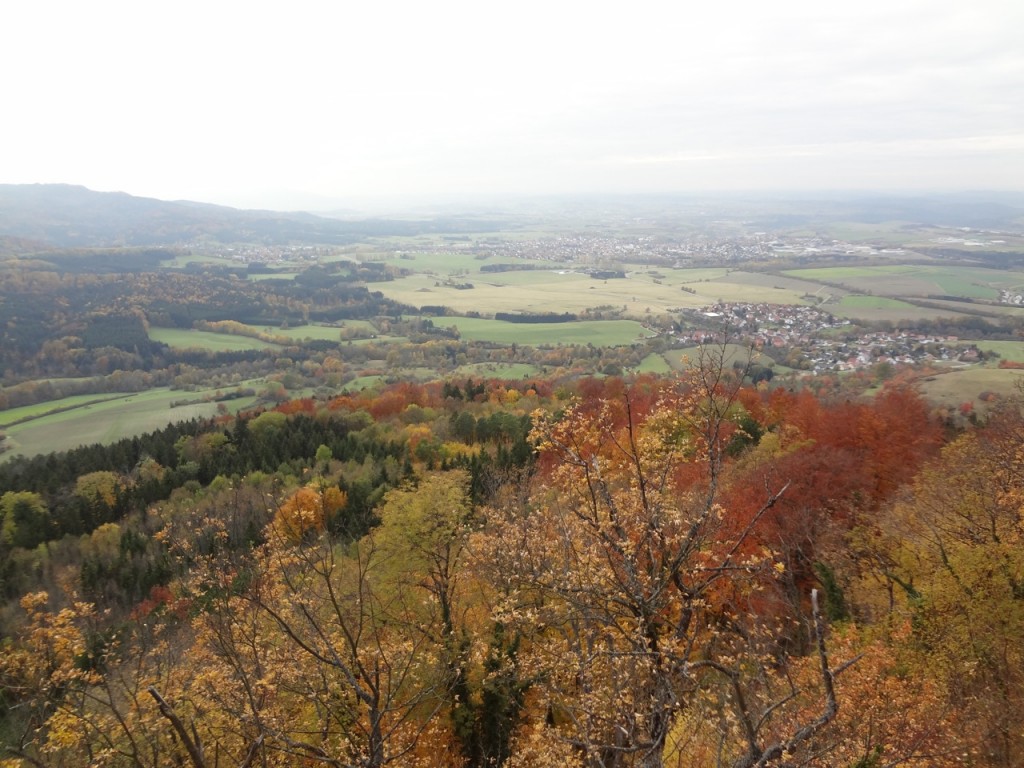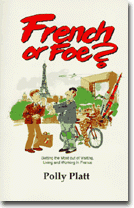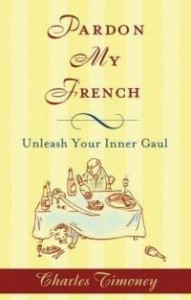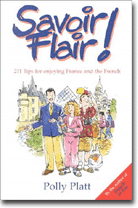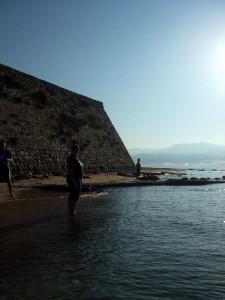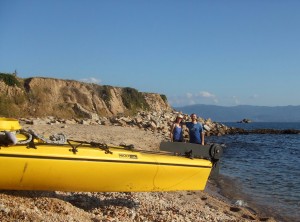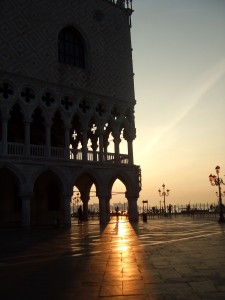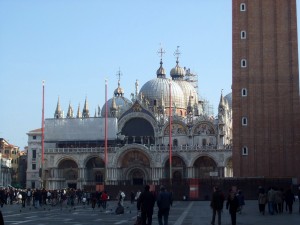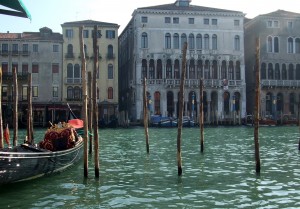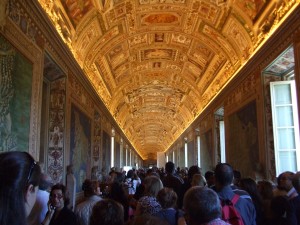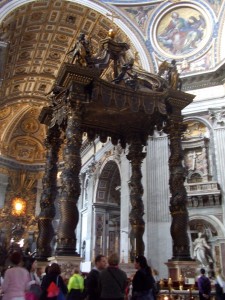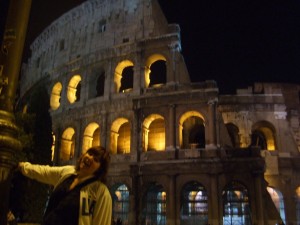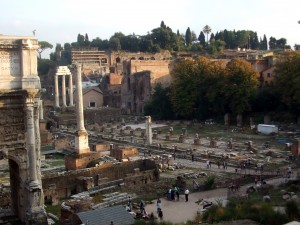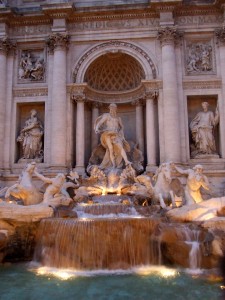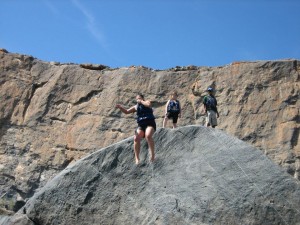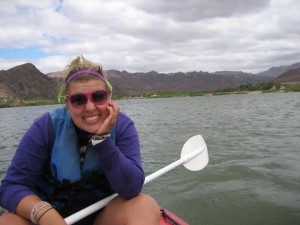Last weekend I had the opportunity to spend a few days visiting a good friend in Frankfurt. Besides short layovers at the train station (one of the largest in Germany), I haven‘t gotten to spend much time in Frankfurt, although I got to know the city pretty well as an exchange student there in early 2009. Jamina (my German friend) was an exchange student at my high school in 2006-2007, and we‘ve kept in contact ever since. Frankfurt is a beautiful city – for a population of “only” roughly 650,000 (a smaller city, for American standards) it’s the only German city with a picturesque skyline full of skyscrapers. Such a cityscape is pretty unusual for Germany. Much like Chicago, Frankfurt is a business-city, specifically, a banking city. Just about every major European bank has an office there, most German banks are based there, it’s where the German Stock Exchange is located, and it is the banking center the European Union. Frankfurt is actually very safe city to visit despite having one of the highest crime rates in Europe. The reason for that statistic is because nearly all credit card fraud and identity theft that occurs in Germany is credited to Frankfurt, where the banks are based. The city itself features many museums, historic buildings (such as the birthplace Goethe), great shopping, excellent public transportation, as well as art, music, and theater.
As a Medical Student, Jamina doesn’t have tons of time to spare, but I was grateful for the long weekend between her exams to visit! On Thursday directly after my classes I left for the train station, and made my way to Stuttgart. I was surprised to have found a train from Stuttgart to Frankfurt for €20 a couple days earlier, which in comparison to the other offers was significantly cheaper. I have a “Bahnkarte 50“ (a discount card for students through German Rail that allows me to pay half price for train travel), which makes the normal-priced tickets seem even more expensive.
**Note for future Tübingen study-abroad students: In my opinion, it‘s really worth it to invest in a Bahnkarte 50 ermäßigt. For €118, you pay half price on all train travel in Germany for the entire year. If you plan on going anywhere out of the immediate Tübingen area, you can really save a lot of money. Even going to Stuttgart, you can save a few euros each way, and if you take more than six train trips throughout the year at an average cost of €40 per round trip (before the reduction) the card will have already paid for itself. That figure is based on the average round trip to Frankfurt and back, (average as in good deal, but not out of the question) as I have lots of friends in the Frankfurt area. If you‘re planning on going further than an hour-and-a-half by train, you can save even more money. Lots of people like to buy the “Eurail“ passes, but in my opinion, it makes much more sense to buy the Bahnkarte 50. That way, you can save money by traveling by train within Germany, and if you want to travel internationally, you can always find cheap flights, thus saving lots of time and lots of money. Eurail passes are quite expensive, and although it‘s something of a European novelty to travel by train, it is not difficult to find good deals on airline tickets, which takes significantly less time. For example, last month we flew round trip to Vienna for €60, and the direct flight from Stuttgart took less than two hours. A train from Stuttgart to Vienna costs minimally €130, requires at least one transfer with layover, and requires minimally seven hours. And Austria borders Germany. Imagine going somewhere even further…**
Anyway, after a short train trip and a tram ride to Jamina‘s apartment, I was treated to a great gluten-free dinner that she cooked for me before catching up on various aspects of life from the past three years, as well as watching a German movie. It‘s amazing how close you remain with good friends, regardless of how much time has passed. Jamina lives in a really cool apartment building near the Commerzbank Arena where the soccer team Eintracht Frankfurt plays. The building itself is actually intended for senior citizens who still live on their own, but because it is subsidized by the government for those living on fixed incomes, students are eligible to live there too. Walking down the hallways, you can tell whether you‘re passing a senior citizen‘s room or a student‘s room depending on whether a bicycle or a walker is sitting outside the door. I had to laugh to myself just a little bit, but the apartment itself was very luxurious compared to the living accommodations of the average American student, and nicer than my German dorm room too! Surprisingly, even though it has a living room, sleeping area, bathroom, and full kitchen, it was only a little more expensive than what I‘m paying per month in Tübingen. Plus, it‘s right on the tram line which makes getting to the city very accessible.
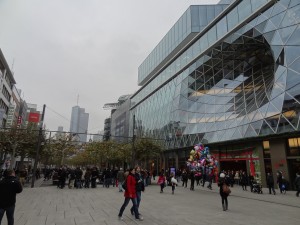
The "Hauptwache" = Trendy shopping district, which is in my opinion, the closest thing you'll find in Germany to Michigan Avenue. If you're an American mall store fan, you'll love it: this mall has one of the only Hollister stores in Germany. If you're into Euro style, this street is also home to five multi-story H&M stores. (Score!)
Although we didn’t have any big plans in particular, we did have the chance to do some shopping, check out the German Film Museum, see an open studio night at big artist studio building, walk through the city, and visit some places I enjoyed as an exchange student, including the European Union Central Bank where the Occupy Frankfurt protest was taking place. I’ve been reading a decent amount about the Occupy fill-in-the-blank protests, and it was interesting to see the one in Frankfurt. I had 5 hours to kill on Friday while Jamina was in class, so it was nice to just wander around a little bit and see how much of the city I remembered! And no visit to Frankfurt would be complete without a visit to a historic area of the city known as “Sachsenhausen” for a glass of Apple Wine, which we also crossed off the list.
I returned from Frankfurt on Sunday night, and Monday evening we were invited to celebrate the Belgian “Sinterklaas” day, which normally takes place on November 6th. It is comparable to the German St. Nikolaus day that some people celebrate in the United States as well. One of our Belgian friends here, Helena, had a visit from her parents two weeks ago, who brought along the largest assortment of Belgian Sinterklaas day chocolate I’ve ever seen. (haha.) They had homemade hot chocolate and Belgian beer for us to sample, and the table was festively decorated. Each place was set with a couple of carefully-arranged Sinterklaas chocolates. They even had a couple extra-large chocolate Sinterklaases (like the chocolate bunnies we eat at Easter) that we broke into and shared amongst ourselves. At the end of the night we were all very full and couldn’t bring ourselves to look at another piece of chocolate, but they had so much left over that they joked about having a second Sinterklaas party this week. German chocolate is quite good, but just as the Europeans will tell you, Swiss and Belgian chocolate is top-quality. It totally puts Hersheys to shame.
According to the tradition, Sinterklaas lives in Spain, and comes to Belgium every November 6th on a ship loaded full of goodies for all the good Belgian children. (There are actually two variations of this holiday in Belgium: The Sinterklaas day on November 6th in one part of the country, and another gift-bearing figure who comes to children in the other half of the country a few weeks later. I’ve forgotten the exact details…) Sinterklaas is one of the sources of the American “Santa Claus“ tradition (hence the similarity between the names) and just like the American version, knows everything about every child. He even keeps a book in which he writes about the goodness or badness of every Belgian child in the half of the country for which he is responsible.
My third adventure for this blog post regards a trip to the Bürgeramt (City Government Building) to visit the most unhappy, unfriendly, and blatantly-rude public workers in the entire Federal Republic of Germany. Much like the DMV, (or as it is known in Indiana, the BMV) the Bürgeramt is full of generally stressed-out and unhappy people, waiting for appointments requiring a library‘s worth of paperwork required for an important document of some sort that you can only hope to receive from somebody who is sick and tired of telling people all day long that they forgot to bring such and such necessary piece of paper. As of last week, I have now been in the European Union for three months, the maximum amount of time granted to tourists to remain in the country. Now that I am no longer officially a tourist, I needed to get a visa (Aufenthaltsgenehmigung) to stay for the rest of the year, and avoid imminent deportation.
Although I managed to bring all of the necessary documents along with my fee of €50, I forgot to convert my height to centimeters. When the woman asked me what my height was, I had no idea what to tell her, as I‘m pretty sure “Six feet, two inches“ would not have held much water on an application for a European visa. She rolled her eyes at me, scowled, and sighed angrily, as she threw her drawer open, pulled out an extendable ruler, and told me to stand against the wall. Out of fear, I complied as she measured me, wrote down my height in centimeters, and angrily slammed the drawer of her desk shut. With that, I was handed an information pamphlet and instructions for my next visit as soon as my visa arrives in the mail from Berlin. Mission Aufenthaltsgenehmigung: accomplished. Deportation avoided. As I walked out, I could hear the same employee shouting (really, shouting) at the people who were next in line. I must have gotten off easy.
That‘s all for this post! I hope everyone had a great Thanksgiving break back at home! Check out Jake‘s upcoming blog to read about our trip to the Ritter Sport Museum and the Thanksgiving dinner we hosted last night for our new international friends. (It must have been an accident, but we managed to pull everything together without burning/ruining anything!)
Bis dann,
Zach

